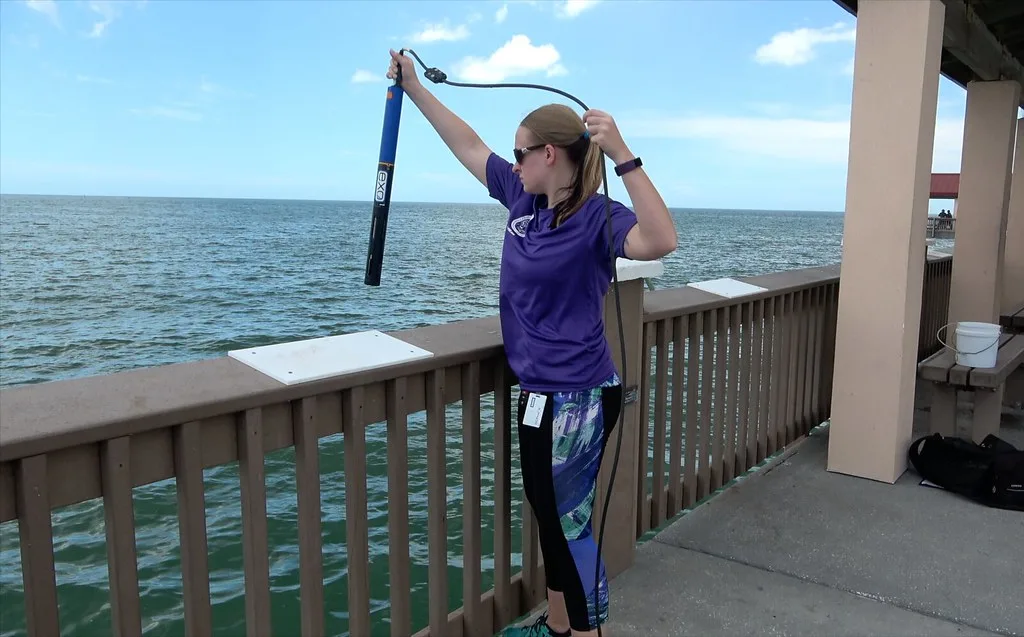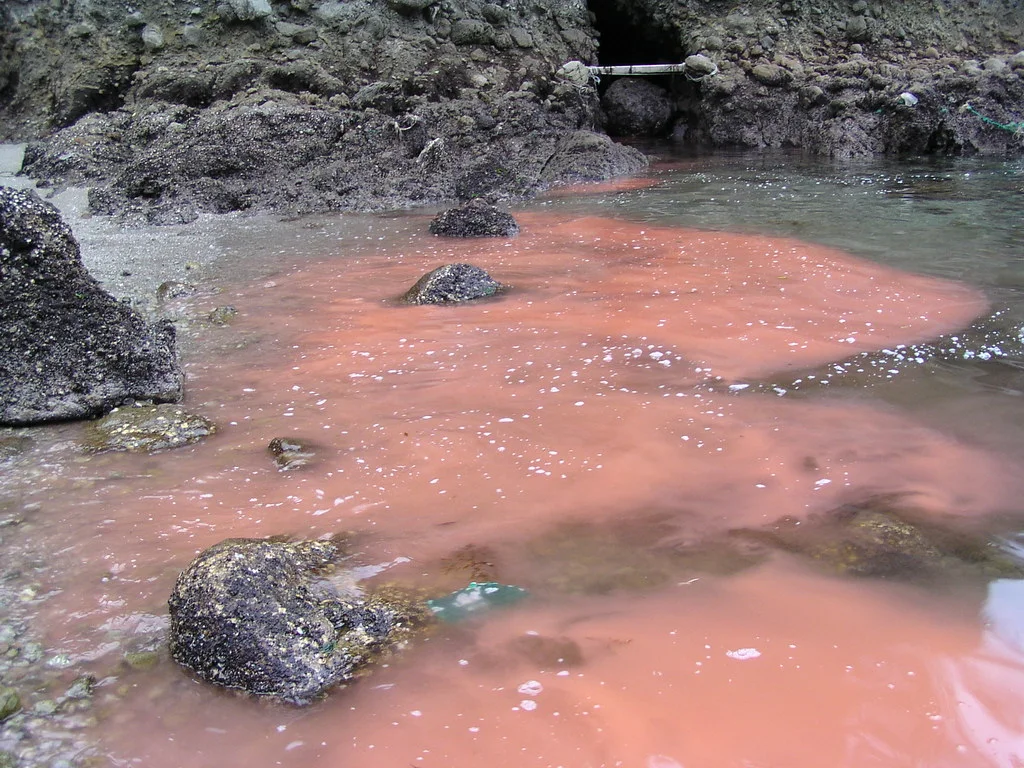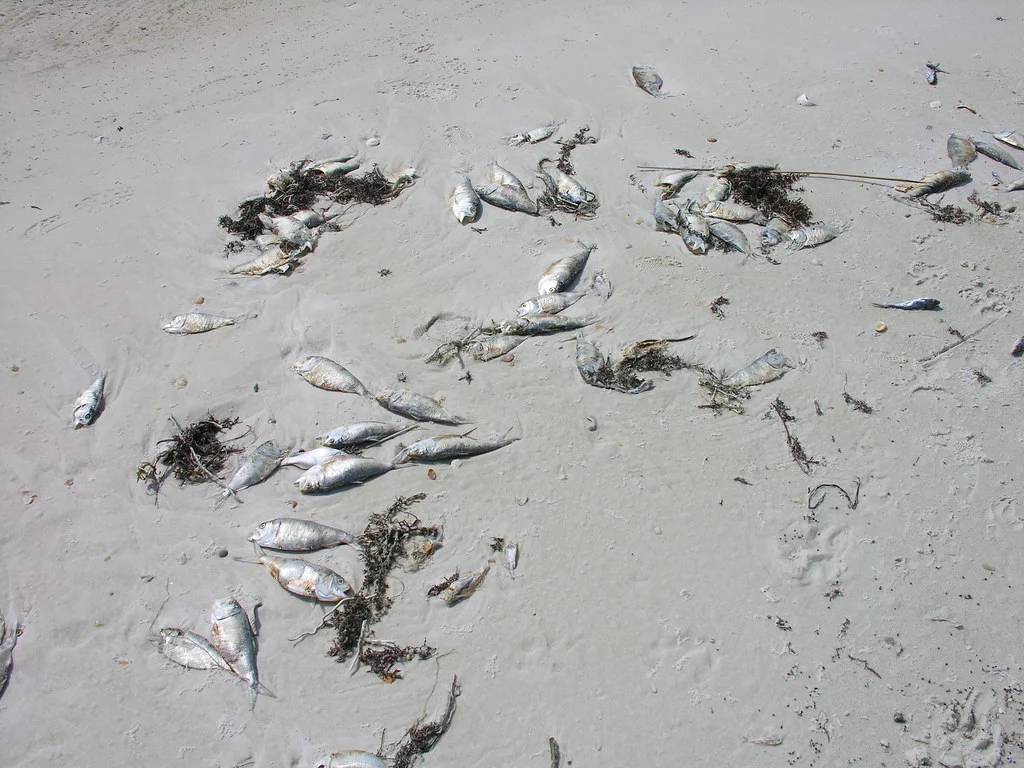Looking for information about Florida’s Red Tide?
Sounds like a hoot doesn’t it? If you’re like me you’ve heard of Red Tide, you may have even been affected by it. But when you take a deeper look there is so much more to it than just some discolored water and some dead fish washed ashore.
Red Tides happen when a particular algae grows out of control. Red Tides or Red Tide Blooms also known by scientists as Harmful Algae Blooms are events that happen along many coasts all over the world. Below are some common questions relating to Red Tide in Florida.
What is Red Tide?
Have you visited a Florida beach recently? Well, if you have you may have noticed a discoloration in the water, maybe an abnormal amount of algae washed ashore.
Even more shocking, you may have noticed an increase in the amount of dead fish and other aquatic life washed ashore. The cause of this troubling occurrence is known as harmful algae blooms or more commonly known as Red Tide and it’s bad news for everyone and everything involved. There are multiple, over 50 to be somewhat exact, species of algae in the Gulf of Mexico alone.
The most common or well-known harmful algae bloom in the Gulf of Mexico is called Karenia Brevis. It is a naturally occurring phytoplankton/algae but it’s quite dangerous. Karenia Brevis produces a neurotoxin that can kill fish and marine mammals and it depletes the water’s oxygen level, causing a mass die-off. While all algae aren’t necessarily dangerous the immense numbers of K. Brevis are wreaking havoc on many Florida beaches.
Huge amounts of dead fish, and we’re not just talking about the little bait fish or a shrimp or two, are the result of the current outburst of Red Tide in canals and beaches on Florida’s gulf coast in and around St. Pete and Tampa. This present deadly Red Tide, which is in some areas as thick as six feet deep at the water’s edge, has reportedly killed Goliath grouper, tarpon rays, and even dolphins and other marine mammals.
Put simply this is an overgrowth of harmful algae that is immensely damaging to multiple ecosystems and many economies that rely on those ecosystems.

Florida’s Red Tide/ Flickr
Why is it called Red Tide?
We know what causes Red Tide, now why is it called “Red”? Red Tides are amazingly eerie to look at but they indicate an unwell ecosystem. But isn’t algae normally green? Whenever I have seen fish tanks that haven’t been cleaned the best they usually have green algae building up, when I visit lakes the algae I see is green. So how did the term come to be in regards to the ocean?
In a nutshell and quite plainly the term “Red Tide” was coined because of the discoloration seen in the water due to the immense numbers of toxic algae concentrations. This phenomenon can be caused by many different factors.
When these organisms are present in large numbers, they produce a toxin that can kill fish and other marine life. These saltwater algae have a red and brown color. In the case of Red Tides all over the world, the concentration of particularly harmful and toxic algae is so immense that they discolor the water to a very observable brown or red color.
Where in Florida is it the Worst?
In 1844 off the Florida Panhandle near Panama City, along the West Florida Shelf, the Gulf of Mexico had its first Red Tide occurrence that has been scientifically verified to have occurred in American waters. In 1999 the Florida Fish and Wildlife Conservation Commission was founded.
Their mission according to their website (1) is, “managing fish and wildlife resources for their long-term well-being and the benefit of people.” They accomplish this through various programs and partnerships with multiple agencies.
The Florida Fish and Wildlife Commission now documents its occurance off the coasts of Florida every year. Their information on it is compiled daily and reported on an interactive map. As of the last update on 1 July 2022, on Florida’s SouthWest coast only background amounts (less than 1,000 cells per liter of sampled sea water) of Karenia brevis were found in one sample from Hillsborough county. K. brevis wasn’t observed in any other sample received from any county.
However, this doesn’t mean that in all of 2022 Florida hasn’t seen high numbers. Simply put, they haven’t been as bad lately as they were in prior years. Historically Red Tide has been most common between Clearwater and Sanibel Island. However, the entirety of the Gulf of Mexico’s coasts are at risk for Red Tide. Defining the “worst” location of Red Tide in Florida is complex. For instance, from winter 2017/2018 to summer 2018/2019 Red Tide bloom, more fish had perished in Lee and Charlotte counties than during previous particularly severe Red Tide outbreaks.
However, a bloom in 2005 caused a dead zone in the Gulf of Mexico that covered 2000 square miles and stretched from New Port Richey to Sarasota. Each Red Tide bloom and other hazardous algal bloom episodes has and has had a significant detrimental impact on the ecosystem, human health, and economic losses with each occurrence. “Worst” would be subjective in this instance.
How Long will it Last in Florida?
August through November is when Red Tide blooms occur most frequently throughout the year. However, Red Tides can and have happened in every month of the year. Because Red Tides are an overgrowth of a living organism there isn’t a certain or definite amount of time the blooms will last.
There is really no set-in-stone amount of time in which Red Tide blooms will dissipate. In Florida, Red Tides can linger for a few weeks and up to a year. For instance, in 2005, a Red Tide bloom began in January off the coast of St. Petersburg, Florida, and continued through most of the year before spreading to Pensacola and Naples. This lasted nearly 13 months before dissipating.
The length of a bloom in Florida’s nearshore waters is determined by the physical and biological factors that affect it. Factors such as the direction of ocean currents, and onshore winds versus offshore winds. Even sunlight, nutrients, salinity, and the velocity at which the bloom is traveling can have differing effects on the duration of Red Tide blooms.
These factors can cause a bloom to appear to have disappeared only for it to then reappear at the end of its life cycle. To predict how the oceanographic conditions in the area will change, researchers are closely monitoring them and utilizing forecasting systems comparable to seasonal weather forecasts. In terms of Red Tides ending altogether or ceasing to exist that’s highly unlikely if not purely imaginative.
As discussed earlier, the first scientific recording of the Red Tide in Florida was in 1844. In the 1700s, Red Tides were reported in the southern Gulf of Mexico, and by the 1840s, they had spread to Florida’s Gulf coast. Even the chronicles of Spanish explorers in the 1500s describe fish kills close to Tampa Bay. One of the worst recorded blooms in Florida was a 30-month bloom that started in 1994 and finished in 1997. These Red Tide blooms have been present for a very long time and will continue for a long time to come.
Is Red Tide Natural? What Causes it?
Red Tides or as scientists prefer to address them Harmful Algal Blooms are a part of nature. Yes, they are natural. Red Tides are not man-made; not fabricated in a lab; they aren’t industrialized. However, they are impacted by industrialization. The dinoflagellate Karenia brevis forms small, relatively innocuous colonies. The Gulf of Mexico and other coastal waters often contain trace levels of the organism, ranging from a few hundred to a few thousand cells per liter of water.
What we refer to as Red Tide begins when these colonies of K. brevis multiply to higher-than-normal proportions. To be a little more accurate, the threshold where K. brevis can become dangerous to our respiratory systems is around 100,000. Florida Red Tide refers specifically to these surges in the K. brevis population because the water may turn red or pink during these events.
To reiterate, K. brevis colonies grow to huge population numbers and become Red Tides or Harmful Algal Blooms. But if the colonies are commonly found in smaller numbers, what is the cause for the increased population size? In a nutshell, food, and environment. At the start, upwelling is a phenomenon in which deep, cold, and nutrient-rich waters rise to the surface, bringing those small harmless colonies of K. brevis cells from the bottom to the surface.
All algae need three things to grow, perfect light, the right temperature, and nutrients. The offshore environment that these colonies ascend to starts providing the nutrients needed for these colonies to grow. As they rise the colonies are also introduced to warmer waters and sunlight. A Red Tide bloom can be sustained by a variety of nutrient sources, including natural ones like decaying marine life and dead fish, but also artificial ones like air pollution and runoff from lawns and streets into our rivers and streams.
To emphasize the increasing number of unnatural nutrients being exposed to these colonies come from water pollution such as pollution from industrial phosphate mines; untreated sewage from sewage treatment plants; sewage leaks from old septic tanks animal sewage from industrial agriculture livestock; fertilizer from industrial farming operations fertilizer from golf courses, yards, and landscaping; untreated groundwater; vehicle and power plant exhaust just to name a few.
As the tides, ebb and flow, and the currents carry the colonies along they are introduced to more and different types of nutrients which allow their numbers to grow exponentially. These small colonies begin growing and can reach numbers from 100,000 cells per liter to a whopping 5 million cells per liter. To sum up, the cause of Red Tide begins with the natural phenomenon of upwelling that introduces these colonies to all kinds of nutrients they wouldn’t naturally have access to, fostering the exponential growth of these tiny microscopic organisms.
Which Florida beaches have Red Tide?
Scrolling through the last couple of months of data from the Florida Fish and Wildlife there have been little to no reports of Red Tide reaching Florida beaches. So far in July 2022 South West Florida reports that in Hillsborough county K. brevis was found at background concentrations which are 0-1,000 cells per liter, no reports of fish kills, and no reports of respiratory irritation suspected due to Red Tide.
NorthWest Florida and Florida’s east coast reported K. brevis was not observed and no other issues as well. Generally, when Florida is affected by Red Tide it is most prevalent throughout Florida’s central and southwest coasts, including the stunning beaches close to Tampa Bay, Sarasota, Anna Maria Island, Sanibel, and Captiva Island.
Red Tides do make it to the southeastern Atlantic coast and not only can they make it up to the north eastern coast of Florida but have even been reported as far north as North Carolina.
What is Red Tide season in Florida?
Florida Fish and Wildlife Conservation Commission has Red Tide blooms occurring for the most part during late summer to early fall. Given that the Red Tide general season is summer to fall, a more precise factor can help predict when Red Tide might become a problem.
Red Tide is significantly impacted by weather conditions. Therefore rain, wind, and ocean currents can also alter its strength and duration.
What are Red Tide Symptoms in Humans?
Red Tides can have an effect on human health in addition to having an effect on marine life. K. brevis cells carry brevetoxins which can cause neurotic shellfish poisoning and ciguatera. Brevetoxins can be consumed or inhaled as a means of exposure. Due to the K. brevis cells’ fragility, waves can rupture them and cause the release of brevetoxins into the air as an aerosol.
Eye, nose, and throat irritation come in different degrees for those in coastal areas. Some people have reported eye and skin irritation, including rashes, after coming into contact with water or sea foam that has a high concentration of Red Tide organisms.
People with severe or persistent respiratory diseases, such as emphysema or asthma, may have serious illnesses as a result of K. brevis. Red Tide can also cause asthma episodes, and people who are vulnerable may have persistent lung symptoms long after leaving the area. Brevetoxins can be found half a mile to a mile and 3/4s inland from the shore during strong Red Tide episodes.
Brevetoxins are a neurotoxin that can be conveyed up the food chain. One of the most common ways for humans to be affected by the Red Tide is by consuming shellfish, such as mussels or clams, that have eaten the algae in a Red Tide. Thus they have just ingested the neurotoxin and can become sick. Best not to eat shellfish during a Red Tide Bloom.
Not only can humans be physically affected by Red Tide but economies have been known to suffer during Red Tide blooms as well. Restaurants and hotels lose revenue; funds must be provided for clean-up efforts of fish kills and other clean-up activities. Losses can also include medical expenses and lost work days. Locals and visitors alike can all be affected by the Red Tide.

Symptoms in Humans/ Flickr
Why is the Red Tide so bad in Florida?
Red Tide is particularly bad in Florida for a number of reasons. One reason is attributed to runoff from stormwater. In Florida, the majority of streams and rivers have their origins in wetlands, however, others come from springs or lakes.
A significant portion of the streams and rivers are underground. The Everglades is a very broad and shallow river that starts in Lake Okeechobee. The majority of the rivers and streams in Florida empty into the Gulf of Mexico. That’s a whole lot of water surface area to gather nutrients from wastewater treatment plants and agricultural lands and bring them to the Gulf of Mexico.
A key nutrient for K. bevis is phosphorus from fertilizer used on farms and ranches in the Kissimmee River Basin. Phosphorus happens to be a crucial nutrient for K. bevis. The Kissimmee River Basin creates the Everglades’ headwaters and empties into Lake Okeechobee, which then flows through rivers and artificial canals to the beaches. Other sources of nutrients are toxic waste from phosphorus mining, even the fish kills caused by Red Tide can feed back into the Red Tide.
As the animal decay, more nutrients are released back into the ocean for K. bevis to thrive on. All of these factors in combination with a complicated network of components, such as increased salinity, altered rainfall patterns, and higher water temperatures, as well as altered coastal upwelling and rising sea levels all contribute to the significance of Florida’s Red Tide.
How does Red Tide affect wildlife?
The same as with humans, wildlife can be affected by the neurotoxins from K. bevis cells. The natural poisons produced by the Red Tide-causing algae are lethal to dolphins, turtles, seabirds, and manatees when present in high concentrations.
And when you have Red Tide Blooms up to 5 million cells per Liter one could imagine the devastation caused. Fish exposed to Red Tide begin to swim erratically and eventually become immobilized because the toxins are so strong.
The exposed fish perish within one hour. Red Tide poisons can cause fish or shellfish to die, which can still injure animals who don’t come into contact with it directly. Fish exposed to Red Tide begin to swim erratically and eventually become immobilized because the toxins are so strong. The exposed fish perish within one hour. Red Tide poisons can cause fish or shellfish to die, which can still injure animals who don’t come into contact with it directly, but who eat the fish or shellfish that have died due to the toxin.
We mentioned the neurotoxin climbing the food chain earlier. In the case of marine life, its effects are twofold. One many prey animals are dying from the toxins leaving either no more food for predators, possibly causing starvation. Two there are now dead animals that are poisoned that become food for scavengers, who in turn die. Not to be too kitschy but it’s the circle of life but the circle has holes or in this case toxins in it. But wait there’s more, Red Tides cause dead zones.
When the algae that cause Red Tide begin to die, dead zones are produced. The rotting of the algae depletes the ocean’s oxygen supply, killing out enormous numbers of fish and other marine life. The fish cannot leave the dead zone since the lack of oxygen causes them to pass out almost instantly. This is where we see such large numbers of fish kills washing up on shore.

Red Tide Affect Wildlife/ Flickr
Can people swim with it?
After reading the effects of Red Tide on marine animals I wouldn’t swim in let alone want to be near the water during a Red Tide Bloom. However, many sources say that people can swim in the Red Tide. Generally, it is safe for most people.
However, some people may have skin irritability and eye burning due to Red Tide. Water may irritate the respiratory tract in those who have respiratory conditions. It’s suggested that people don’t swim near dead fish because they may contain dangerous bacteria.
Obviously getting out of the water and completely washing off is a measure to be taken if your skin, eyes or throat start to feel irritated. All in all, yes people can swim when it is happening. Taking a common sense approach is strongly encouraged when deciding to swim in toxin filled poisonous water.
Can Dogs be Walked on Beaches with it?
This would be about the same answer as the question: can people swim in Red Tide. It is advised that If you take your dog to the beach, keep them away from any dead fish. The likelihood that they will become ill increases significantly if they handle or consume dead fish.
So, the answer isn’t necessarily no but precautions should be taken. If your dog swims, wash them as quickly as you can because as most dogs are known to do they will lick their fur thus ingesting any poisons from their coat. Pets can still come into contact with seafoam, which can contain Red Tide, so even strolling down the shore poses a risk.
Exposure can cause neurological and gastrointestinal symptoms such as tremors, seizures, stumbling, paralysis, vomiting, diarrhea, and drooling. Low blood pressure and a slow heartbeat may potentially affect your dog. After exposure, symptoms might appear within 30 to 1 hour, and they need to be treated right away.
There are quite a few risks associated with walking your dog on the beach during a bloom. As with swimming in a Red Tide bloom, it is recommended to use a common sense approach when deciding to walk your dog during a bloom.
***
I sincerely hope you were able to learn something new after reading about Red Tides in Florida. Y’all be safe out there and leave only footprints.
****
More Florida:

